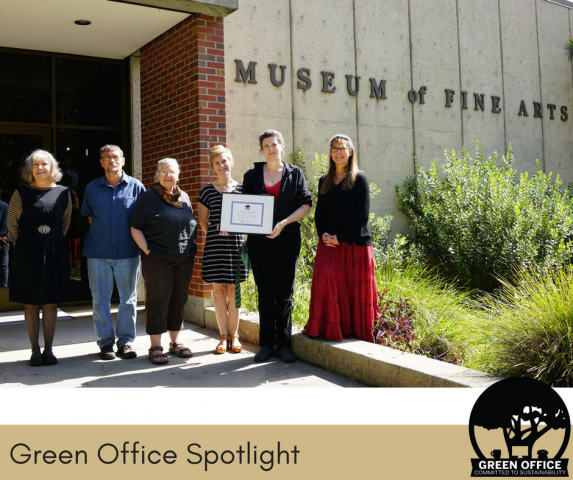Green Office Spotlight: FSU Museum of Fine Arts (MoFA)

We are spotlighting the FSU Museum of Fine Arts (MoFA) office for being a Green Office! They are reducing costs with LED lighting, ensuring office staff know how to recycle, and encouraging electronic document sharing over printing.
When your green office first started, how did people feel about it and how did they respond? Any challenges, confusion or excitement?
Everyone was happy to be part of the official program. As we all already practiced green procedures and recycled becoming part of the program didn’t produce any challenges or confusion.
Are there any specific members in your office who are avidly committed to sustainability and would like to expand upon their experiences as a green office member? Have any office members adopted sustainability in their lives outside of work?
We are all committed to sustainability both in and out of the office. It is something we all feel is in important for preserving the environment, becoming most energy efficient in general and increasing productivity.
What green office projects have been most successful in your office? Why do you think they are the most successful?
Our most successful project, to date, was, as I previously discussed, having our incandescent track lighting lamps in the Museum’s upstairs gallery spaces replaced with energy efficient LED lamps. The new lamps save approximately $3,000 annually and the project will pay for itself in about 3 more years. In addition, because the LEDs don’t create any heat, we also save on air conditioning. In addition, the cooler LEDs extend the life of works of art and protect them from fading. We hope to be able to have the lamps on the lower level of the Museum replaced in the future.
Why is sustainability important to your office?
Our future and the future of our children depend on employing sustainable practices in all areas of life, both at home and on the job. Everyday new technologies provide us the resources to become even more sustainable and enables us to better protect the environment and live healthier lives.
What sustainable practices does your office employ? (E.g. biking, carpooling, & recycling)
The sustainable practices of the Museum revolve primarily around recycling and reducing energy usage. Although, we are a small staff, due to employees’ schedules and location of homes, carpooling isn’t a viable option. That being said, our Director, weather permitting, rides her bike to work almost every day.
Offices in the Museum are equipped with motion sensor lights that go off automatically if no movement is detected. We encourage the use of electronic sharing of documents when possible to reduce the copier usage, the use of paper and, in addition, to improve productivity and communication.
The Museum has blinds on all windows which not only keep the heat out, but also ensures minimal UV-exposure for the safety of the artworks. In 2015, we had 200 of our incandescent track lighting lamps in the Museum’s upstairs gallery spaces replaced with energy efficient LED lamps. The new lamps save approximately $3,000 annually and the project will pay for itself in about 3 more years. In addition, because the LEDs don’t create any heat, we also save on air conditioning!
How many recycling bins are in your office? What type of recycling bins does your office have?
We have two main recycling bins for paper, one on each of the two levels of the Museum. At the main entrance to the Fine Arts Building there is a recycling receptacle for plastics, bottles and cans. As all staff use re-fillable beverage containers, there is no real need for us to have a bottle and can bin located in the Museum proper.
Do you hold any special events that are designated as green events, or do you try to incorporate sustainability into all special events?
For special events at the Museum, (exhibition opening receptions) we use reusable serving platters. In addition, we serve, almost exclusively, finger foods to eliminate the need for providing plates. However, due to the number of guests at openings (sometimes as many as 1,000 people), unfortunately, it is not possible to provide re-usable glassware. However, this coming season, we are going to implement two trash receptacles and label them for the visitors so that they place their cups into the “plastic recycle” bin. We provide punch at openings and water in urns, eliminating the need for individual beverage containers, but plan to ask for the public to participate in recycling at events this coming season. All wine bottles get recycled at the end of the evening/event as do plastic juice or soft drink containers.
Was it difficult establishing sustainability as an informal norm in the office?
The Museum has always practiced sustainability, even prior to becoming an official Green certified office, so it was not difficult at all to establish green practices as a norm here.
How do you ensure that faculty and staff are educated on what can and cannot be recycled?
We have signage at the main recycling and trash containers encouraging staff to recycle and stating what can be recycled. In addition, most emails from the Green Office are forwarded to all employees.
How does your office understand and participate in social, environmental, and economic sustainability?
The Museum always strives to be more efficient and incorporate sustainable business practices, when possible, allowing us to focus our resources where they matter most. Which, in addition to, reducing our global footprint, also provides cost savings.

